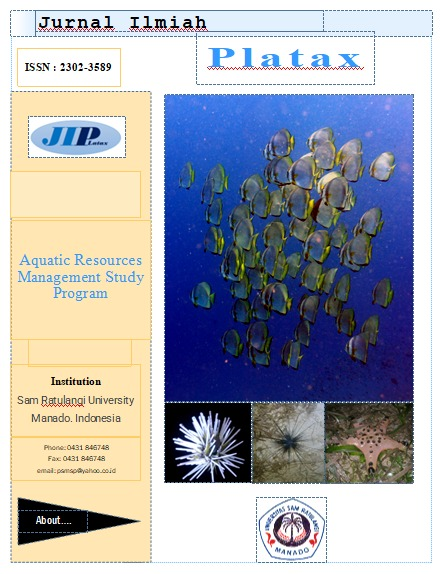Composition Of Types And Distribution Of Faviidae Corals In The Bahowo Reef Fall, Tongkaina, Manado City
DOI:
https://doi.org/10.35800/jip.v10i1.37295Keywords:
Hermatypic, Genera, Ecosystem, QuadratAbstract
Coral reef is an ecosystem built by calcium-producing marine biota, especially corals. One of the reef-building corals (hermatypic) is Faviidae that is distributed in almost all territories of Indonesia. This study was carried out in the reef flat of Bahowo, Tongkaina, Manado. Data collections used the sampling method with quadrat. There were 6 genera of Faviidae recorded in this study, Favia, Favites, Goniastrea, Leptoria, Montastrea, and Platygyra with clumped distribution patterns.
Keywords: hermatypic; genera; ecosystem; quadrat.
Â
Abstrak
Terumbu karang merupakan ekosistem yang dibangun oleh biota laut penghasil kapur, terutama oleh hewan karang. Salah satu karang pembentuk terumbu (hermatipik) adalah karang batu Faviidae yang memiliki penyebaran hampir di seluruh wilayah Indonesia. Penelitian ini dilakukan di rataan terumbu Bahowo, kelurahan Tongkaina, kota Manado. Berdasarkan hasil pencatatan data dengan menggunakan metode sampling kuadrat yang kemudian diolah dan dianalisis secara statistik dengan menggunakan perangkat lunak (MS Excel) diperoleh 6 genera karang batu Faviidae, yaitu Favia, Favites, Goniastrea, Leptoria, Montastrea, dan Platygyra dengan pola distribusi yang mengelompok.
Kata kunci: hermatipik; ekosistem; genera; kuadrat.
References
Aldilla A., Anggi Z., Haryadi N.P., Sigid, 2014. Analisis kondisi habitat karang di pulau Rimaubalak, Kandangbalak, dan Panjurit Lampung Selatan. Tesis. Sekolah Pasca Sarjana. Institut Pertanian Bogor. Bogor. Hal 18
Dahuri, R., Dutton I.M. 2000. Integrated coastal and marine management enters a new era in Indonesia. Integrated Coastal Zone Management 1: 11-16.
Edinger, E.N., J. Jompa, G.V Limmon, W. Widjatmoko, & M.J. Risk. 1998. Reef degradation and coral biodiversity in Indonesia: effects of landbased pollution, destructive fishing practices, and changes over time. Marine Pollution Bulletin, 36: 617– 630.
Guntur. 2011 Ekologi karang pada terumbu buatan. Ghalia Indonesia. Semarang
Halidu, A., Lalamentik, L., & Rembet, U. (2016). Distribution of Coral Reefs Stone at the Reef Flat of South Coast Putus-Putus Island East Ratatotok, Ratatotok District Southeast Minahasa Regency. Jurnal Ilmiah PLATAX, 4(1), 19-30. doi:https://doi.org/10.35800/jip.4.1.2016.13229
Kurniawan, D. 2011. Studi pertumbuhan dan tingkat kelangsungan hidup karang goniopora stokesii (Blainville 1830) Mengunakan teknik biorock. Skripsi. Universitas Hasanuddin. Makassar. Hal 40
Morgan, S. 1998. Coral reef the ecology and local anthropogenic effects. University of Waterloo. 31 pp
Morisita, M., 1959. Measuring of dispersion of individuals and analysis of the distributional patterns. Memories of the Faculty of Science Kyushu University Series E (Biology), 2(4): 215 – 235.
Nasaru, J., Lalamentik, L., & Rembet, U. (2017). Distribution of Pocillopora verrucosa (Ellis dan Solander, 1786) at the Reef Flat of South Coast Putus-Putus Island East Ratatotok, Ratatotok District Southeast Minahasa Regency. Jurnal Ilmiah PLATAX, 5(1), 61-68. doi:https://doi.org/10.35800/jip.5.1.2017.15152
Obura, D. 2008. Resilience assessment of coral reefs-draft manual IUCN CCCR Resilience assessment methodology. 23pp
Odum, Eugene P. 1994. (Terjemahan: Tjahjono Samingan) Dasar-dasar ekologi edisi ketiga. Yogyakarta: Gadjah Mada University Press. Hal 191
Rondonuwu, A., Rembet, U., Moningkey, R., Tombokan, J., Kambey, A., & Wantasen, A. (2014). Coral Fishes the Famili Chaetodontidae in Coral Reef Waters of Para Island Sub District Tatoareng, Sangihe Kepulauan Regency. Jurnal Ilmiah PLATAX, 1(4), 210 - 215. doi:https://doi.org/10.35800/jip.1.4.2013.3705
Russell, 2009. Coral finder Indo-Pasific. The Australian coral reef society. 10-16 pp
Suharsono, 1996. Jenis-jenis Karang yang Umum dijumpai di Perairan Indonesia. Lembaga Ilmu Pengetahuan Indonesia Pusat Penelitian dan Pengembangan Oseanologi. Jakarta. Hal. 1
Suharsono, 2008. Jenis-jenis Karang di Indonesia. pusat penelitian dan pengembangan oseanografi-LIPI. Jakarta. Hal iii + v
Suleman, Y., Lalamentik, L., & Rembet, U. (2017). The Distribution of Favites abdita Coral Reef (Ellis and Solander, 1786) in the Land of Coral Coast Village of Malalayang Dua, Malalayang sub-district Manado. Jurnal Ilmiah PLATAX, 5(1), 69-76. doi:https://doi.org/10.35800/jip.5.1.2017.15154
Suprapto, 2002. Struktur komunitas karang hermatipik pada mikro-atol dataran Terumbu Pulau Panjang, Jepara. Skripsi. Jurusan ilmu kelautan UNDIP. Semarang. Hal 72 + iv
Thamrin. 2006. Karang: Biologi, reproduksi dan ekologi. Minamandiri Press. Pekanbaru. Hal 22
Tianran, C., Kefu, Y. U., Qi, S. H. I., Shu, L. I., Price, G. J., Rong, W., Meixia, Z., Tegu, C. Jianxin, Z. 2009. Twenty-five years of change in scleractinian coral communities of Daya Bay (northern South China Sea) and its response to the 2008 AD extreme cold climate event. Chinese Science Bulletin, 54: Hal 2107-2117.
Tombokan, J., Rembet, U., & Pratasik, S. (2017). Vertical Distribution Of Hard Corals In Southern Siladen Island. Jurnal Ilmiah PLATAX, 5(1), 49-60. doi:https://doi.org/10.35800/jip.5.1.2017.14972
Veron, J.E.N., 2000. Corals of the World Volume 1. Australian Institute of Marine Science and CRR Qld. Australia 3. 595 pp.
Veron, J.E.N., 2000. Corals of the World Volume 3. Australian Institute of Marine Science and CRR Qld. Australia. 443-516 pp
Zar, Jerrold H. 1984. Biostatistical analysis. Library of congress cataloging in publication data, United States of America. Hal 728
Downloads
Additional Files
Published
How to Cite
Issue
Section
License
COPYRIGHT
Authors who publish with this journal agree to the following terms:
Authors hold their copyright and grant this journal the privilege of first publication, with the work simultaneously licensed under a Creative Commons Attribution License that permits others to impart the work with an acknowledgment of the work's origin and initial publication by this journal.
Authors can enter into separate or additional contractual arrangements for the non-exclusive distribution of the journal's published version of the work (for example, post it to an institutional repository or publish it in a book), with an acknowledgment of its underlying publication in this journal.
Authors are permitted and encouraged to post their work online (for example, in institutional repositories or on their website) as it can lead to productive exchanges, as well as earlier and greater citation of the published work (See The Effect of Open Access).






































